Reviewed by Dr Jessica Gunawan and Physician Chu I Ta
3 Millennials Share Their Korean Diet for Clear Skin: You Can Start Today!
Published | 12 min read
We interview some people who follow the Korean diet to get clear skin. Are you interested in following this trend as well?
The whole world is fascinated by Korean food, culture, and K-pop idols. Besides their singing and acting talents, K-pop idols are also admired for their beautiful glass skin. So, how do they get their glowing complexions? Koreans follow a daily skincare routine with high-quality skincare products, of course, but there’s more. The Korean diet revolves around a centuries-old tradition of eating healthy food prepared in healthy ways.
Gastronomic Culture of a Korean Diet
Based on the Journal of Ethnic Foods, Taoist philosophy states that health is a state of balance – when Yin-Yang and the five elements are in equilibrium, then a person’s body will be healthy. Koreans believe that Yin-Yang energy creates the 5 elements of wood, fire, earth, metal, and water. These elements exist in the form of the harmonious colours of green, red, yellow, white, and black. That’s why a Korean meal must incorporate all of these colours. They mainly represent vegetable dishes that are healthy and low in calories.
This philosophy is similar to the belief of Traditional Chinese Medicine (TCM), which revolves around the importance of eating foods of various colours, as well as different grains for your health and wellness. It is also indicated in 2 excerpts — “五色五味入五脏” (five colours and five flavours enter into the five internal organs) and “五谷为养” (grain for nourishment) — from the Yellow Emperor’s Classic of Internal Medicine, which is the fundamental source for TCM.
Simply put, these excerpts state that foods that consist of the 5 colours (red, green, yellow, white, and black) and flavours (sweet, sour, bitter, pungent, and salty) will enter the five Zang-Fu organs (heart, spleen, liver, lungs and kidneys). In addition, it also recommends the consumption of grains like rice, beans, broomcorn, wheat, and millet.
Therefore, following a traditional Korean diet would mean eating a lot of vegetables and fruits, as well as getting adequate amounts of vitamins, minerals, and fibre. The Korean diet also incorporates a lot of fish and seafood. Traditionally, a Korean meal consists of cooked rice (bap), dishes with broth (kuk), kimchi, and side dishes (banchan).
All these practices promote good health and well-being. Thus it’s reflected on the skin, which is the most visible part of the body.
Medicinal Foods in a Korean Diet
Based on a classic quote from the Yellow Emperor’s Internal Classic, “空腹食之为食物,患者食之为药物,” TCM believes that food is medicine and medicine is food. Interestingly, Greek physician Hippocrates also has a similar quote, “Let food be thy medicine, and let medicine be thy food.” Leaning on this borrowed wisdom from TCM, Koreans have developed a concept on dietary consumption that correlates to disease prevention and treatment – Yak Sik Dong Won, where the body’s healing resources are the same as the sources of eating.
In a Korean diet, herbs and spices are used for their medicinal values. Thus, many of their common ingredients have many health benefits. Therefore, they cook herbs and fruits such as ginger, cinnamon, and ginseng for the flavours and the health benefits, according to the Korean Functional Foods: Composition, Processing and Health Benefits.
Pomegranate is good for the skin too. Experimental and Therapeutic Medicine finds that pomegranate juice concentrated powder positively affects skin ageing induced by ultraviolet rays. Besides that, it also has anti-ageing and anti-inflammatory effects.
Korean Diet Staples That Promote Clear Skin
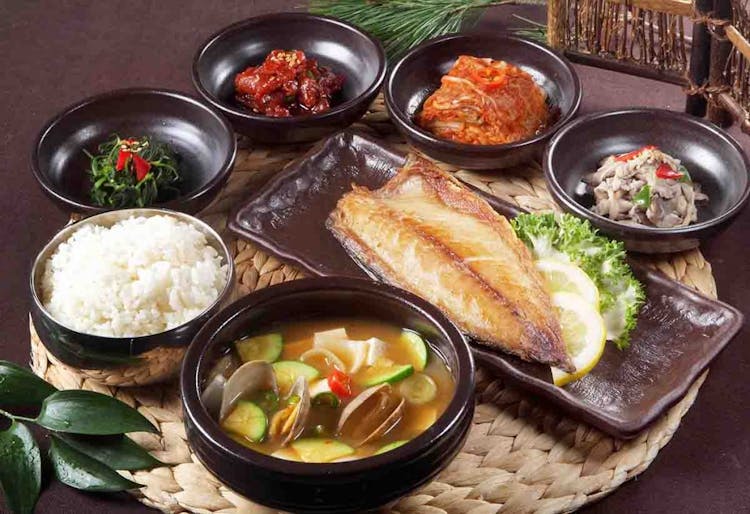
You are what you eat. So, if you want to be healthy, you need to eat nutritious food cooked in healthy ways that retain nutrients. As an extension of that, if you wish to have beautiful dewy skin, what you consume is just as important as what you apply on your skin.
“There are a lot of vitamins and minerals that we must eat so that we can have healthy skin. For example, vitamins A, B complex, D, E, C, as well as zinc and iodine are all needed to maintain healthy skin, hair and nails,” says Chief Physician Chu I Ta. He elaborates that Vitamin E is very important because of its antioxidant properties. It contributes to the protection of cells from oxidative stress – which can protect skin from premature ageing and wrinkles.
“Vitamin C is also found in a lot of Korean food, especially the seaweed soup. A very nutritive food well known for calcium, iodine.” Physician Chu adds. “Vitamin C contributes towards skin collagen, which links to the plumpness and elasticity of our skin. So, if your body is lacking Vitamin C, it could lead to dry skin, wrinkles, fine lines, and premature ageing.”
Traditionally, the Korean diet is low-glycaemic, vegetable- and seafood-based. What typical dishes do South Koreans consume for their enviably plump skin? We talk to three healthy millennials who swear by the Korean diet – and here are the top 5 foods that they consume often.
1. Kimchi
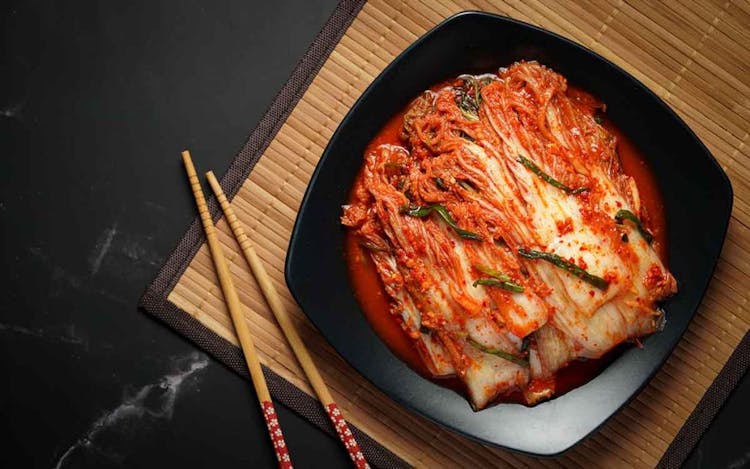
A traditional, fermented Korean food, kimchi is consumed daily by Koreans, and its health benefits have been recognised. The common ingredients used to make kimchi are cabbage, garlic, ginger, and red pepper powder. It is rich in vitamins, minerals, dietary fibre, lactic acid bacteria, and other active compounds.
Moreover, being a fermented food, kimchi is a probiotic powerhouse. It contains the good bacteria Lactobacillus, which promotes a balance of microbiome in the gut. This helps to improve your skin, as inflammation in the gut relates to skin issues, such as acne.
TCM believes that dampness and heat in the body can cause acne. Dampness can weaken the spleen and stomach systems and cause internal heat. Therefore, you should consume sour-flavoured kimchi. It can also help to dispel heat from the body and improve stomach digestion, thus alleviating acne.
Kenex Kum, a 38-year-old food experimentalist, shares that the basic ingredients in kimchi help preserve youth and maintain a healthy gut. “The acne problems I used to have on my back are now gone since I started eating kimchi,” she says.
You can also try Kombucha Pu’er Tea. Made using a natural fermentation process with Pu’er tea in urns, this drink is a good source of probiotics that can improve your digestion.
2. Seaweed soup
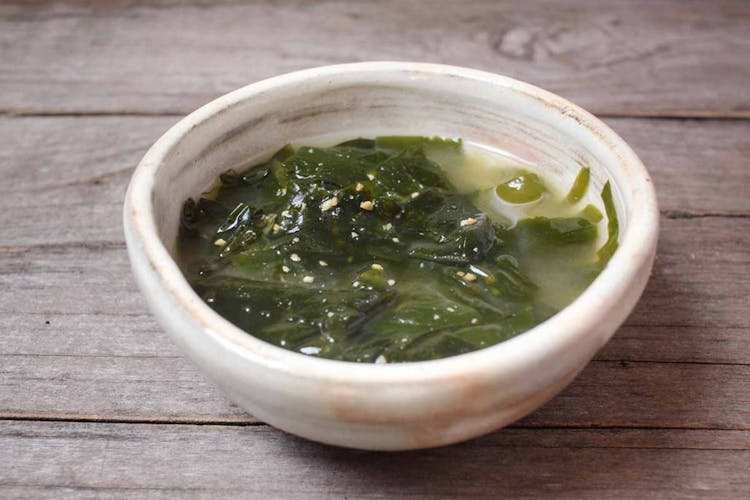
The Korean diet bases heavily on plants and foods from the sea, so it’s a natural choice that they would add seaweed, or miyeok, to their diet. Side dishes made from seaweed are very popular in traditional Korean cuisine. So, Koreans add seaweed as a fresh ingredient in salads and soups or eaten as snacks.
Marine Drugs journal shares that overexposure of the human skin to environmental stress, such as UV rays, pollution, and free radicals, increases skin-related problems such as hyperpigmentation and premature ageing. However, seaweeds in a marine environment have evolved to survive under stress conditions by developing biologically active components. These active components are beneficial for their antioxidant, antibacterial, anti-ageing, and moisturisation effects.
Seaweed consumption can also help dissipate nodules, thus suggesting that eating this delicacy can help people with nodular acne — a severe form of acne that causes large, inflamed, and painful breakouts — achieve clearer skin.
Angele Koh, a 34-year-old sales and marketing manager, enjoys healthy cooking methods such as boiling. “Seaweed soup is among my favourite Korean food,” Koh says. “Seaweed soup is a great source of calcium, iodine, fibre, and vitamin B, which is good for the skin.”
Meanwhile, Stephanie Chan, a 40-year-old architect, enjoys banchan, especially vegetables, carrots, and beans. “My digestive tract is healthier when I eat more vegetables,” Chan says, adding that her body feels good afterwards, unlike after a heavy meat-based meal.
Neutral and sweet in nature, TCM uses Chinese barley to improve blood circulation and reduce nodules. It can also help to purify and whiten skin and improve obesity by promoting healthy weight loss. Poria mushrooms, too, can be beneficial for skin health. This herb is naturally moisturising and is rich in antioxidants that can help to reduce wrinkles and fine facial lines. Meanwhile, combining Dahurian Angelica root (bai zhi) with Chinese barley and Poria can help to whiten skin.
3. Soybean soup
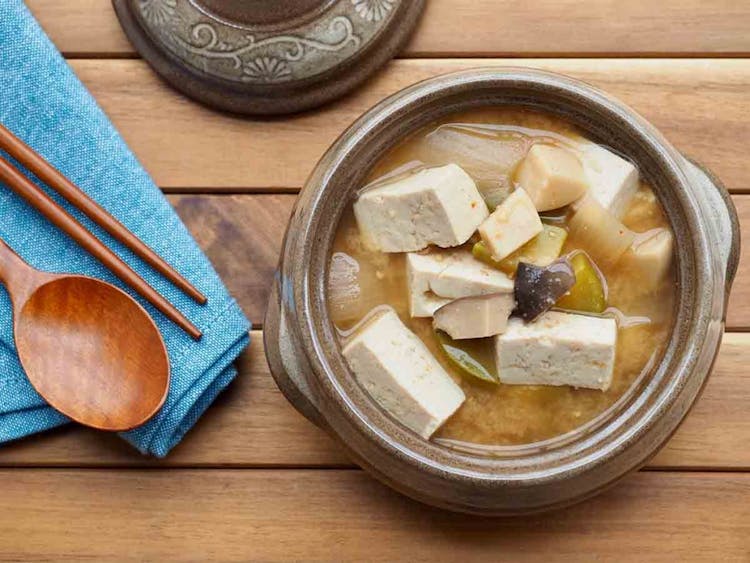
Chan believes in the power of fermented foods, as they contain probiotics. “I notice that my overall health and energy levels have improved with regular intake of foods rich in probiotics,” she says. “I also get better sleep at night after taking a probiotic supplement. So why not make a dish that is also tasty at the same time?”
Korean soybean paste is known as doenjang. Traditionally, people used it as a condiment in cooking, including soups, stews, and salad dressings. You can make doenjang by fermenting soybean with Bacillus subtilis and moulds such as Aspergillus, Rhizopus and Mucor species. Its fermentation period is from 2 to 24 months. Soybean is also a probiotic that enhances digestion by strengthening the spleen, whilst also helping to better your gut and eventually, skin health.
A 2019 study finds that doenjang has anti-obesity, anti-diabetic, anticancer, and anti-inflammatory properties. Doenjang can help prevent increased blood pressure. Moreover, Lactobacillus rhamnosus in doenjang could aid in generating bioactive peptides.
There is growing research on bioactive peptides to investigate their uses in products developed to prevent skin ageing, stimulate collagen and elastin synthesis, and improve skin healing, as stated in Cosmetics journal.
Particularly, those who are busy may benefit from taking probiotic supplements, which can help keep your skin radiant and enhance your overall health.
4. Barley tea
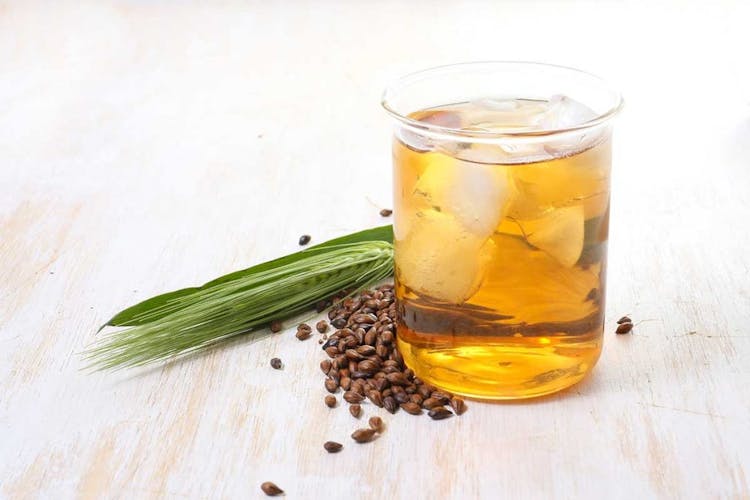
“A good diet will help you to have good gut flora, which is, of course, important for all aspects of your body, even your skin,” Koh says.
Barley is a powerhouse of phytonutrients. The Science Reporter states that selenium present in barley helps preserve the skin’s elasticity by protecting it against free radical damage. It’s not surprising that barley tea is arguably the most popular beverage in Korea.
Barley tea contains vitamin A and carotenoid which help initiate cell growth for managing skin problems due to its antioxidant properties. It also contains minerals and amino acids that are beneficial for health. This whole grain is a rich source of fibre that is essential for maintaining a healthy gut.
Moreover, the significant level of melatonin – known as a sleep hormone – in barley can help to improve sleep quality. When you’re able to have deep sleep, the rise in growth hormones allows damaged cells to become repaired. Though, barley tea is not the same as barley water. In fact, barley tea is prepared by steeping roasted barley in hot water, whereas barley water is made by boiling raw barley kernels.
5. Makgeolli
Like barley tea, you can also consume Makgeolli (fermented rice wine) to provide your body with an abundance of vitamins and minerals, amino and organic acids, protein, and fibre.
Physician Chu says, “Makgeolli is very nutritious and contains 80% water and 6–8% alcohol. Makgeolli is unfiltered and thus contains high levels of lactic acid and Lactobacillus bacteria, at the level found in yoghurt. It also contains dietary fibre. This aids digestion, improves immune function and slows the ageing process.”
He adds, “The microbiological and chemical composition of Makgeolli provides a complex probiotic effect owing to the presence of lactic acid bacteria and yeast. The metabolic substances produced during fermentation have proven nutraceutical activities. Makgeolli may also have various physiological effects including antioxidant, anti-hypertensive, anti-diabetes and anti-cancer activities.”
From a TCM perspective, you can consume Makgeolli to improve blood circulation, warm the body by eliminating cold, and improve appetite and digestion. Nevertheless, people with weak spleen digestion and soft stools should take it moderately.
Alternatively, rosebuds are a common TCM herb that you can consume as a tonic to provide your body with a sufficient intake of vitamins A, B, C, E, and K. It works to regulate the liver and dispel stress from a TCM perspective. It also contains a compound called tannin, which is especially good for women, as it helps to improve menstrual secretion, increases estrogen levels in the body and improves their facial complexion.
Despite the craze around Korean skincare, when it comes to your skin health, what really counts is what’s inside. Korean food is flavourful and contains a lot of natural ingredients. So, start incorporating the Korean diet into your meal, and you’re one step closer to getting flawless skin.
References
- Cosmetics. 2018. Bioactive Peptides: Applications and Relevance for Cosmeceuticals. [Accessed 5 June 2021]
- Experimental and Therapeutic Medicine. 2017. Beneficial effects of dried pomegranate juice concentrated powder on ultraviolet B-induced skin photoaging in hairless mice. [Accessed 5 June 2021]
- Fisheries and Aquatic Sciences. 2018. Nutrients and bioactive potentials of edible green and red seaweed in Korea. [Accessed 5 June 2021]
- International Journal on Recent Scientific Research. 2018. A Brief Review on Hazelnuts. [Accessed 5 June 2021]
- Journal of Ethnic Foods. 2016. Korean Diet: Characteristics and historical background. [Accessed 5 June 2021]
- Journal of Ethnic Foods. 2019. Medicinal food understanding in Korean gastronomic culture. [Accessed 5 June 2021]
- Korean Functional Foods: Composition, Processing and Health Benefits. 2018. Korean foods – History, Culture, and Characteristics. [Accessed 5 June 2021]
- Marine Drugs. 2019. Potential Use of Seaweed Bioactive Compounds in Skincare—A Review. [Accessed 5 June 2021]
- Medicine. 2018. Effects of Kimchi on human health. [Accessed 5 June 2021]
- Nutrients. 2019. Effects of Doenjang, a Traditional Korean Soybean Paste, with High-Salt Diet on Blood Pressure in Sprague–Dawley Rats. [Accessed 30 May 2021]
- Science Reporter. 2016. Healthy Barley. [Accessed 5 June 2021]
Share this article on

